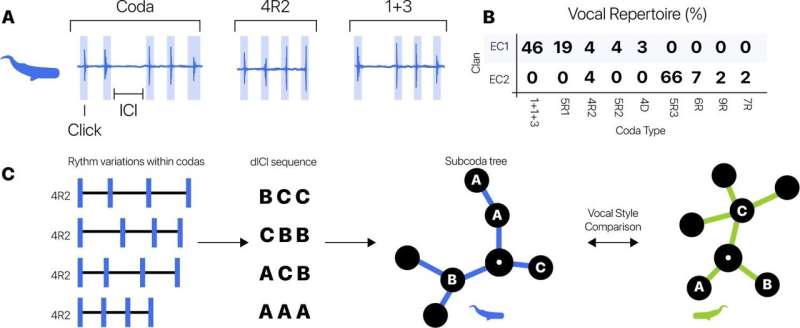This article has been reviewed according to Science X's editorial process and policies. Editors have highlighted the following attributes while ensuring the content's credibility:
fact-checked
peer-reviewed publication
trusted source
proofread
How neighboring whales learn each other's language

Researchers from Project CETI (Cetacean Translation Initiative) and collaborating institutions have developed a method to investigate sperm whale communication by determining their vocal style, finding that groups living in close proximity can develop similar styles to each other.
The study, published as a reviewed preprint in eLife, contributes to a richer understanding of communication between whales. The editors say it provides solid evidence for the existence of social learning between neighboring sperm whale clans.
The methodology developed by the team could also be used as a framework for comparing communication systems in other species, to gain a deeper understanding of vocal and cultural transmission within non-human societies.
Sperm whales live in multilevel societies. This allows them to engage in complex social behaviors, such as cooperative hunting, and also facilitates the transmission of knowledge and cultural behaviors across generations.
Sperm whales communicate through rhythmic patterns of clicks called codas. The set of vocalized coda types combined with how frequently they are used makes up a vocal repertoire.
"While there is evidence of individual variations in vocal repertoires, sperm whales belonging to the same social unit share a common vocal repertoire that persists across many years—these are referred to as part of the same clan," says lead author Antonio Leitao, a Ph.D. student at Scuola Normale Superiore in Pisa and member of Project CETI.
"There is a clear social segregation between members of different clans, even when living close together. Different clans are characterized by identity codas, which typically account for a minority of total codas vocalized by each whale."
Previous work on sperm whale communication has mostly used vocal repertoires to distinguish between individual whales, social units, or clans. Leitao and colleagues aimed to investigate the differences in structure within codas to gain a deeper understanding of the variations in sperm whale communication. Each coda can be broken down into a sequence of inter-click intervals (ICIs).
So, they created a model using a technique called variable length Markov chains, which allowed them to estimate the probability of observing a specific ICI, based on the previous one. This data could then be used to create a subcoda tree for an individual whale or clan, which contains information about all of the important rhythmic variations and transitions between ICIs—their vocal style.
To test the validity of their method, the team analyzed two datasets of sperm whale vocalizations, from the Pacific and Atlantic Oceans. The Atlantic dataset comprised two different clans and had rich annotations of the coda types recorded, the identity of the vocalizing whales and their social relations.
They generated subcoda trees for each social unit and, when they compared between them, the team discovered that trees from different social units within the same clan were much more similar than those between members of different clans.
Without using the information on the clan memberships of the recorded whales, the team were able to use their vocal style to accurately sort them into their respective clans, validating their method. They also extended this to the much larger Pacific dataset, which was far less detailed than the Atlantic data, with only the locations of the recordings being available. Nevertheless, they were able to determine the whales' clan membership based on the similarity of their vocal style.
During these studies, the team also analyzed how proximity between clans and social units affects their vocal style. Previous work had explored whether the identity codas used by whales differ based on proximity to other clans.
It revealed that greater spatial overlap between clans caused their respective identity coda repertoires to become more different from each other, by modulating the frequency with which they are vocalized. No difference was found for non-identity codas.
When analyzing vocal style, the team observed an opposite effect—closer proximity between clans increased the similarity of their vocal style, while no change was observed for identity codas. This suggests that geographic overlap between clans causes their vocal styles to become more similar, but does not jeopardize their ability to use identity codas to signify their clan membership.
"The increase in similarity of non-identity coda vocal styles is most likely the result of social learning," claims Leitao. "Identity codas are consistently maintained to allow the recognition of fellow clan members, but we believe that social learning between clans leads to a more similar vocal style with other whales that are within acoustic range."
The authors call for more research to fully confirm their evidence for this social learning in sperm whales. Namely, conducting the same analyses on a larger dataset would add more statistical power, and a longitudinal analysis over time could provide direct evidence for the existence of social learning between clans and rule out the alternative possibilities of genetic or environmental factors playing a role.
"Our results strengthen previous results on the use of identity codas as symbolic markers, while supporting cultural transmission and social learning of vocalizations among whales of different clans," says senior author Giovanni Petri, who is Lead of Network Science at Project CETI, Professor at the Network Science Institute at Northeastern University London and and Principal Researcher at the CENTAI Institute.
"We suggest that vocal learning in sperm whales may not be limited to vertical transmission from adults to their kin, but that horizontal social learning from outside the immediate family unit may also be occurring."
More information: Antonio Leitao et al, Evidence of social learning across symbolic cultural barriers in sperm whales, eLife (2024). DOI: 10.7554/eLife.96362.1
Journal information: eLife
Provided by eLife


















